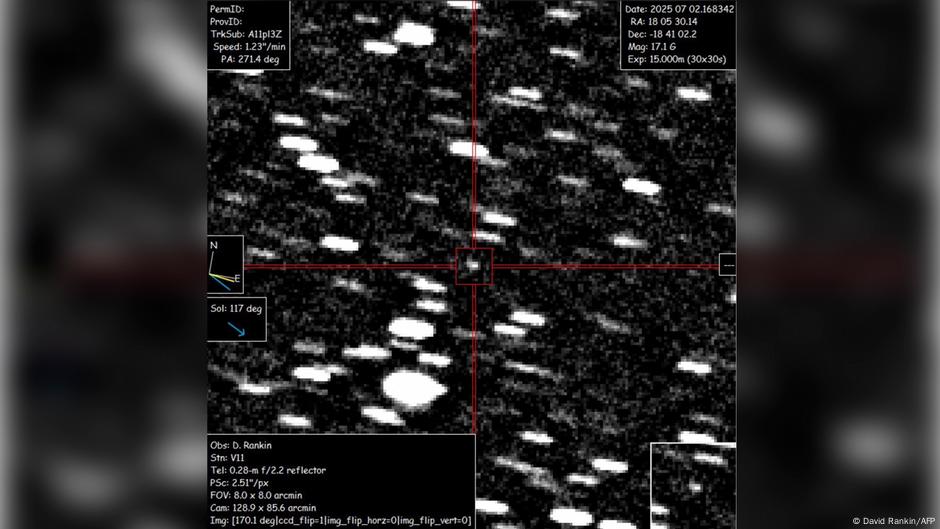
The Third Interstellar Object: What We Know About 3I/ATLAS
In recent years, the universe has made its presence known in a surprising way. According to the European Space Agency, this is the third time an interstellar object has entered our solar system since 2017. While it’s fascinating to witness such cosmic visitors, it also raises questions about how prepared we are for these rare encounters.
The latest object, named 3I/ATLAS, was first spotted on July 1, 2025, by the ATLAS telescope in Chile. It is now recognized as a comet that is approximately 670 million kilometers (416 million miles) away from the sun. Astronomers have confirmed that it poses no threat to Earth, but there is still much uncertainty surrounding its characteristics and behavior.
Larry Denneau, co-principal investigator at ATLAS, admitted that scientists do not yet have a complete understanding of this object. “We don’t know very much,” he said. This honesty is reassuring, even if it highlights the need for further research.
Key Details About 3I/ATLAS
As of now, astronomers have gathered some basic data about 3I/ATLAS. It is estimated to be around 20 kilometers (12.4 miles) wide and traveling at a speed of about 60 kilometers per second (134,000 miles per hour). Its closest approach to Earth will occur in October, when it will be about 240 million kilometers away — more than 1.5 times the distance between Earth and the sun, and roughly 624 times the distance between Earth and the moon.
Richard Moissl, who leads the European Space Agency’s Planetary Defense office, noted that scientists are still refining their understanding of the comet’s velocity and trajectory. This information is crucial for making accurate predictions about its future path.
Despite the limited data, the detection of 3I/ATLAS was made possible by advanced technology and continuous monitoring. The Asteroid Terrestrial-impact Last Alert System in Chile was the first to spot the object on an unusual trajectory. Soon after, other teams in Hawaii and Australia confirmed it as an interstellar comet.
Moissl mentioned that the comet is showing signs of cometary activity, which means it may begin to release gas and dust as it gets closer to the sun.
Open Questions and Scientific Curiosity
One of the most intriguing aspects of 3I/ATLAS is its origin. Like the previous interstellar objects, 1I/'Oumuamua and 2I/Borisov, it came from outside our solar system. These objects are believed to be remnants from other planetary systems or even fragments from the early universe.
Moissl stated that 3I/ATLAS appears to have come from the direction of the Galactic Center region, which is located at the heart of the Milky Way. However, scientists do not yet know its exact source or "home star."
Compared to 1I/'Oumuamua and 2I/Borisov, 3I/ATLAS seems larger based on its brightness. This suggests that it may have a different composition or history. Astronomers are eager to continue studying the comet to learn more about its properties.
As it moves closer to the sun, 3I/ATLAS may start to sublimate — a process where frozen gases turn into vapor, creating a glowing coma and a tail of dust and ice particles. This could make it more visible from Earth.
Future Observations and Research
For now, 3I/ATLAS is expected to be visible with a telescope starting in September. However, when it reaches its closest point to Earth, it will be hidden behind the sun. It should reappear in early December, offering another opportunity for observation.
Looking ahead, advancements in technology will likely lead to more discoveries of interstellar objects. The Legacy Survey in Space and Time at the Vera Rubin Observatory in Chile, set to go online this year, is expected to detect several new interstellar objects over the next decade.
Additionally, the Comet Interceptor mission, led by Michael Kueppers, is scheduled to launch in 2029. This spacecraft will remain in a "parking orbit" and be ready to intercept any distant comets or asteroids that come too close to Earth.
Conclusion
The arrival of 3I/ATLAS reminds us of the vast and mysterious nature of the universe. While scientists are working to understand this interstellar visitor, there is still much to learn. As technology improves and more telescopes come online, we can expect to encounter more of these cosmic wanderers in the years to come.
Post a Comment